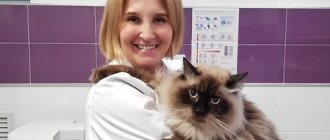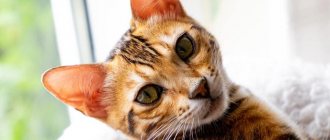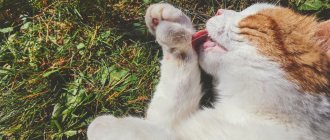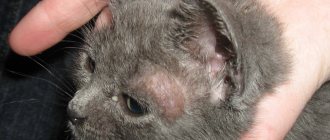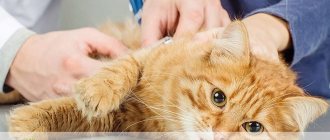Causes Signs Diagnosis Treatment Epistaxis - bleeding from the nasal passages. Occurs when the capillaries of the nasal cavity are damaged or blood clotting is impaired. Bleeding can develop acutely (for example, as a result of injury or a fight with another cat), or it can manifest itself as a chronic symptom (for example, with an infection of the nasal passages, a polypoid growth on the nasal mucosa).
As a rule, when blood flows profusely from the nasal passages, the cat begins to actively sneeze, which only aggravates the situation and contributes to further damage to the blood vessels and blood splattering.
If you notice blood coming from your pet's nose, you should immediately contact a veterinary clinic! Do not use medications yourself and remember that epistakis can indicate serious illnesses that require hospital treatment and careful monitoring of the patient’s vital signs.
If your cat is sneezing and has bloody discharge from his nose
First of all, if you notice red discharge from the nose when your pet sneezes, you should not panic. Sometimes this happens if the animal's nasal capillaries are too close to the surface. And then, when excited, the pet may bleed from the nose.
After the bleeding has stopped, rinse your nose with warm water and dry with a towel, clearing the nasal passages.
If, when sneezing with blood, the bleeding does not stop, then it is possible to help the animal by placing a cold object on its back - this will serve as a signal to the capillaries, and they will narrow. Eventually the bleeding should stop.
© shutterstock
If all these procedures do not help the animal who is sneezing, you should seek help from a veterinarian.
What should I do at home if my pet sneezes?
All pets that are experiencing sneezing and snorting with increasing frequency should visit a veterinarian. Here are a couple of simple, common sense tips for pet owners whose animals sneeze or snort constantly.
- Limit your pet's movement.
Place your pet in a crate or small area (such as a bedroom or bathroom) to observe his behavior. - Don't overload your pet.
Long walks or exercise should be avoided until you can take your pet to the vet. - Take your pet's temperature.
If your pet has a high fever (over 40-41 degrees), contact your veterinarian as soon as possible.
If your pet is suffering from other obvious symptoms, such as difficulty breathing, pain, poor appetite, or is simply acting differently than usual, take him to the vet immediately - if necessary, to a hospital with a intensive care unit. Additionally, if there is nasal discharge or the sneezing is productive, meaning mucus, blood, or other discharge is produced, your pet should see a doctor. These are usually signs of a more urgent health condition than the advice given here.
If you don't know what to do, call your veterinarian or animal emergency clinic.
Causes of nosebleeds in cats
The cat's nasal cavity is lined with mucous membrane containing blood vessels and nerves. Most often, nosebleeds are the result of injury to small vessels due to mechanical damage or inflammation of the nasal mucosa. But there may be more serious reasons.
Injury. Damage resulting from a puncture (for example, from a plant with a hard spine), a fight with another animal, or an accident (kick, fall, car accident, etc.) Foreign body. Sometimes some small object or debris (a grain, a piece of stem or twig, etc.) can get into the cat’s nasal cavity.
A tumor growing in a cat's nose. Nasal tumors are most common in older cats
Pay attention to the shape of the cat's muzzle, since neoplasms usually lead to its asymmetry or deformation, swelling, changes in the integrity or color of the skin of the nose, unequal size of the eyeballs, watery eyes, etc. Dental problem
Often the cause of a nasal infection is a dental infection. For example, an abscess (purulent inflammation of tissue) of a tooth root often affects the nasal sinus cavity. The infection will interfere with the normal functioning of the nasal mucosa, which leads to its dryness and bleeding. Hypertension (high blood pressure). An increase in blood pressure leads to rupture of small capillaries in the nasal mucosa, which leads to bleeding. Blood clotting disorder. Platelets (colorless blood cells) are responsible for the formation of blood clots and stopping bleeding (clotting). If there are not enough platelets, the blood becomes thin, which causes bleeding.
Currently, many diseases have been identified that lead to poor blood clotting. With such diseases, other signs are usually observed (for example, the appearance of red spots on the gums and ears, pale gums, lethargy, loss of energy). Reduced blood clotting in a cat can occur due to a decrease in the number of platelets in the blood (for example, with viral leukemia, viral immunodeficiency, side effects of chemotherapy drugs and non-steroidal anti-inflammatory drugs, some tumors, with autoimmune thrombocytopenia), or with pathologies of the blood coagulation system (for example, with DIC syndrome, liver failure, hemophilia).
Poisoning with certain substances, for example, Warfarin (a drug with an anti-clotting effect), hemolytic poisons (substances that cause hemolysis), can also cause nosebleeds, possibly severe.
- Nasal infection. Nasal discharge, including blood, is a consequence of bacterial, viral respiratory diseases, and rhinitis.
- Pulmonary hemorrhage. Lung tumor, pulmonary edema, injury to lung tissue lead to respiratory failure and circulatory disorders, which affects the condition of all organs and systems. The functions of the liver and lungs are also affected, and the blood clotting process is disrupted.
- Poisoning with rat poison. The ingredients in rat poison affect your cat's blood clotting, which may cause bleeding. Cat poisoning is possible either through direct contact with the poison or through eating a poisoned rodent.
- Parasites. The cause of disturbances in the circulatory system and blood composition (in particular, damage to platelets) can also be fungal diseases, such as histoplasmosis and blastomycosis, as well as rickettsial infections transmitted by ticks.
Nosebleeds can also be caused by parasites that feed on the cat's blood - fleas and ticks. A very severe infection with these parasites can lead to a decrease in the number of platelets responsible for blood clotting.
Sneezing. Inflammation (for example, as a result of a respiratory infection, runny nose) or simply irritation of the nasal mucosa can cause a cat to sneeze violently, which in turn provokes nosebleeds. Sneezing can slow down natural blood clotting.
If the bleeding is one-time, caused by a minor injury and stops quickly, then there is no reason to worry.
If the bleeding is frequent, regularly repeated, accompanied by large loss of blood, and other symptoms are present, a visit to the veterinary clinic is a must!
Rhinitis in cats
A runny nose in cats is most often caused by a cold. Rhinitis can also be the result of an allergy - to dust, perfume, air freshener or other household chemicals. If rhinitis is not treated, it becomes chronic - then it is dangerous due to the growth of polyps and adenoids. How can you tell if a cat’s runny nose is due to an allergy? The discharge is watery, sneezing is frequent. If there is an infection, the discharge becomes colored, becomes viscous and has a specific odor.
With rhinitis, a cat's nose becomes red, especially the edges of the nostrils, wheezing is heard when breathing, and with infections - lacrimation and the formation of crusts under the eyes.
Diagnosis and treatment
If you notice alarming symptoms, you should not try to diagnose your cat yourself. It is necessary to show it to a specialist. It should be remembered that self-medication can cause unnecessary suffering to the animal and not achieve recovery. The dosages of human medications are most often such that they are completely unsuitable for our smaller brothers, and giving them to a cat can cause serious harm to its health.
Your pet should be treated at home, strictly following the veterinarian's recommendations.
If your cat has allergies, your doctor will prescribe antihistamines and also advise you to avoid contact with agents that provoke allergic reactions.
For infectious diseases, antibiotics, antiviral, and antifungal agents are prescribed. A runny nose can be treated by rinsing the nasal passages. The doctor may also prescribe anti-inflammatory drugs, immunomodulators, and probiotics.
If sneezing is caused by the penetration of a foreign body into the respiratory tract, and the cat cannot get rid of it on its own, then the veterinarian will perform an endoscopic intervention to remove the foreign object.
Polyps and other tumors in the nasal passages are eliminated surgically. The operation is simple, but necessary.
Cats suffering from asthma are prescribed inhaled corticosteroids to relieve attacks, basic therapy. Cancer is treated, as in humans, with radiation therapy and strong chemicals. surgery is often required. Parasitic infestations – with the use of anthelmintics.
Why does my pet sneeze?
The sneezing process can be caused by various reasons. If your cat sneezed violently just a few times in a row, then most likely dust particles got into her nose. Frequent sneezing occurs due to:
- allergies;
- foreign body in the respiratory tract;
- diseases of the respiratory system;
- worms;
- problems with teeth.
Allergies in cats
Cats, like people, experience allergic reactions. Animals begin to sneeze and rub their noses with their paws. Often, allergies develop to chemical detergents and cleaning products that owners use when cleaning their homes. Allergens also include plant pollen and cigarette smoke. Some cats start sneezing because of cat litter. Their eyes water.
Finding out the cause of an allergic reaction is quite difficult. If your pet starts sneezing, then look at what objects it comes into contact with, remember what chemicals you used when you had to do the cleaning. For example, you washed the cat's food bowl using some kind of detergent, or sprayed air freshener in the presence of the animal.
Presence of a foreign body
When eating food in a hurry, pieces of food, water, and during play - small objects (buttons, small parts from toys, pins) get into the respiratory tract. Fluids leave the respiratory system due to a reflex contraction of the muscles of the larynx.
With solid objects the situation is different. They linger inside, constantly causing a sneezing reflex and coughing. If a foreign body enters your cat's respiratory tract, contact your veterinarian immediately for help. In such cases, you cannot hesitate, because it is difficult for the animal to breathe. It may die.
Respiratory system diseases
Sneezing is a sign that the cat has a cold or has some kind of respiratory illness. For example, a cat fell ill with rhinitis. With this disease, the nasal mucosa becomes inflamed due to parasites or mechanical damage. In addition to sneezing, the following symptoms are observed:
- eyes water;
- a runny nose appears (snot of a serous, mucous, mucopurulent nature);
- crusts appear around the animal’s nostrils;
- wheezing is heard when breathing;
- inhalations and exhalations are made through the mouth;
- the animal does not eat well;
- The pet has a hot nose.
Treatment of rhinitis consists of eliminating the cause of the disease. Veterinarians recommend cleaning the nasal passages of cats, rinsing them with astringent solutions, and inhaling sulfonamides and antibiotics.
The reason why a cat sneezes several times in a row may be due to bronchial asthma. When the disease occurs, attacks of suffocation are observed. A sick animal, as a rule, sits with its neck stretched out, sniffles, wheezes, coughs, and tries to breathe through its mouth. If your pet has difficulty breathing, you should immediately take it to a veterinary clinic. After diagnosis, the doctor will advise treating the disease at home with drugs that dilate the bronchi.
Helminths
Do cats sneeze from worms? This is a pressing question for pet owners. Helminths sometimes cause sneezing. Some types of parasites, when they enter the intestines, do not remain there, but penetrate through the mucous membrane into the blood vessels, then enter the lungs through the bloodstream. Being in the bronchi, helminths cause irritation. When sneezing and coughing, they enter the oral cavity and are swallowed again by the animal.
Heartworms are very dangerous. Veterinarians, identifying them, immediately prescribe treatment. Worms enter the body after a mosquito bite. Helminth larvae travel through the bloodstream to the heart, where they remain. The growth and development of worms occurs in the organ.
Adults cause blockage of arteries. The pet begins to breathe heavily, sneeze and cough. As a result, infection with heartworms leads to a sad outcome - the cat has a heart attack and dies. That is why it is necessary to treat helminthic infestations.
Dental problems
Another reason for sneezing is bad teeth. Infectious and inflammatory processes occurring in the oral cavity often spread to the nasal area. In this regard, the domestic cat begins to sneeze and rub its nose with its paw for no apparent reason, and snot appears. Due to her illness, she doesn't eat well.
To save your pet from dental problems, take him to the veterinarian. Appropriate treatment (such as tooth or tartar removal) may be required. To prevent oral diseases in your pet, use a special toothpaste for animals or purchase food, some of which have now begun to help partially remove plaque.
What to do if your cat sneezes
There are many reasons for frequent sneezing. Some of which are harmless. A simple reminder will help owners understand them:
- Single sneeze – no need to do anything.
- The cat sneezed several times, then stopped - it is worth observing the condition for the next 2-3 hours. If the sneezing does not recur, nothing needs to be done.
- A cat always sneezes in the same circumstances (during feeding, on the bed, after the owner has used an aerosol or smoked) - eliminate the provoking factor.
- The pet has a stuffy nose, his breathing is hoarse, similar to snoring - provide his favorite food, drink plenty of fluids, avoid drafts, hypothermia.
- Signs of a cold persist for more than 2 days without noticeable relief - consult a veterinarian.
- Purulent discharge from the nose has appeared - ensure the highest possible hygiene of the coat.
- Bloody discharge - apply a cold compress.
- Transparent, but plentiful - provide care for the coat.
- Any discharge that persists for more than a day without noticeable improvement - contact your veterinarian.
- The appearance of purulent discharge from the eyes, especially if the kitten’s eyes are purulent, contact a veterinarian.
- Bad breath, refusal to eat, vomiting, diarrhea - contact your veterinarian.
- The cat periodically breathes hoarsely, opens its mouth, attacks occur under the same conditions - contact a veterinarian.
My cat sneezes and snorts. What's the matter? General information
Sneezing and snorting seem like obvious enough signs to identify, but it's not always easy to tell them apart in pets. Indeed, these two symptoms can sometimes appear so that many people use the terms interchangeably. Sneezing is usually defined as a sudden, involuntary movement of air from the lungs through the nose and mouth. This phenomenon usually occurs in response to some irritant of the upper respiratory tract, most often to the thin receptor structures of the mucous membrane that lines the nasal passages.
A snort, on the other hand, looks and is identically defined as a sneeze. The difference is that sneezing is involuntary, while snorting is a voluntary effort on the part of the pet.
Dogs and cats sneeze and snort for a variety of reasons related to the functioning of the upper respiratory tract. While many are normal and benign reactions to simple irritation, some may signal infections, upper airway obstructions, and allergic diseases. There are also other pathological conditions of the upper respiratory tract.
Types of allergic rhinitis
There are two types of allergic rhinitis: chronic (year-round) and seasonal. The first appears all year round, since the allergens that cause it are always present in a person’s life. And the second is associated with the seasonal flowering of plants and the appearance of spores of some fungi (Cladosporium, Penicillium, Alternaria).
A characteristic sign of seasonal rhinitis is an increase in symptoms when certain plants appear outside during flowering, using cosmetics and medications containing extracts of plants to which a person is allergic, deterioration in health when coming into contact with rotten grass, and so on.
With persistent rhinitis, sensitivity to allergens of dust mites, animals, birds, insect allergens (from insects), food allergens, mold fungi and chemical elements (platinum salts, chromium compounds, nickel compounds, epoxy resins, etc.) increases.
If no pathologies are detected
In order not to provoke a new attack, the animal is protected from stress. This helps stabilize emotional levels and pressure.
You cannot leave a cat on the street unattended: it can suffer from the actions of street animals, damage the nasal mucosa from hard leaves and thorns of plants, and their seeds.
It is important to undergo regular veterinary and dental examinations . This will prevent the development of inflammatory processes.
A nutritious diet with the introduction of vitamin complexes is the best prevention of anemia and a decrease in the level of platelets in the blood.
How to treat allergic rhinitis
Three main methods are used to treat the disease:
- non-medicinal (removal of allergens),
- medicinal (using various drugs),
- surgical.
The first two methods are discussed in detail in the previous paragraph, and now we will talk about the third.
Surgical intervention is performed in three cases: when non-drug and drug treatment methods do not help, when correction of structural disorders of the nasal cavity and paranasal sinuses is needed, when pathologies appear (purulent or polypous sinusitis, etc.). This method is distinguished by its accuracy, the ability to penetrate any part of the nose and sinuses where surgery is necessary, functionality and efficiency. If the operation is performed in a timely manner, recovery and return to a full life occurs quickly and without serious complications.
Important: operations are performed with complete exclusion of contact with the allergen. The procedure is not carried out during flowering or other active exposure to allergens.).
After surgery, scars, osteomyelitis, empty nose syndrome, facial pain, bleeding, and atrophic rhinitis may occur.
In addition to surgical intervention, laser coagulation (cauterization) of the nasal turbinates is also performed (submucosal, targeted, selective ablation of hypertrophied areas).
Among the most effective drugs for the treatment of sinusitis symptoms are
Sialor Rhino based on silver ions. It has an anti-inflammatory effect and prevents the proliferation of bacteria. Thanks to the mild action of the drug, the balance of microflora is maintained and favorable conditions are created for the regeneration of the nasal mucosa.
Diagnostics
In order to find out why a cat’s nose is bleeding, the veterinarian prescribes a comprehensive examination of the animal.
Diagnostic methods:
- Tests are performed: general or biochemical blood test, coagulation test, endoscopy, biopsy, cytology, x-ray examination of the nasal cavity;
- A careful visual examination, examination of the nasal as well as oral tracts, mouth, lower nostrils, throat.
- Urinalysis to assess liver function;
- Serological tests are carried out for the presence of fungal diseases, as well as infections caused by ticks;
- Carrying out computed tomography, magnetic resonance imaging;
- Rhinoscopy;
- Blood pressure measurement;
- Surgery for residual diagnosis.
The need for a specific diagnostic method is determined by the veterinarian depending on the complexity of the symptoms. After the diagnosis is established, treatment is prescribed to eliminate the bleeding, as well as the reasons that caused it.
First aid for a cat with a nosebleed
So, the cat has blood coming out of its nose. If a runny nose initially occurs and streaks of blood appear in the mucus, this condition is most likely not critical, although it also requires certain actions (more about this in the article “What to do when a cat sneezes and has snot?”).
The release of drops, and even more so a trickle of blood, can seriously frighten the owner. What to do if your cat has a bleeding nose? First of all, put off panic. The owner's anxiety can agitate the pet, and this will lead to increased blood pressure and, as a result, increased bleeding.
Try to calm down: now the health of your beloved animal depends on your composure. Provide your pet with silence and a calm environment.
If moderate to severe nosebleeds develop, it is better to adhere to the following algorithm of actions:
- Apply something cold to the bridge of your nose, such as an ice pack or something wrapped in a cloth from the freezer. This must be done in such a way as not to prevent the animal from breathing freely.
- Find out where the nearest veterinary clinic equipped with a rhinoscope is located. If there is no one nearby, then go to any other one or call a veterinarian at home.
- While you are waiting for a doctor's examination, if possible, carefully examine the animal yourself - its face and mouth. Remember what medications you gave the cat, whether there was access to the street, etc. If the animal feels unwell, has pale mucous membranes and rapid breathing, and the bleeding continues, then the clinic can see you without a queue.
If veterinary care is not available, cold treatment should be applied until the bleeding subsides. You can gently rinse your nose with aminocaproic acid - this is a hemostatic agent sold in a regular pharmacy. We talked in detail about the technique of rinsing the nose of cats in the article “What to do at home if a cat sneezes?”
Unfortunately, it is impossible to determine the exact causes at home - only a specialist can do this.
Should I worry?
Nosebleeds are an alarming symptom, but you should not panic. The animal needs to be calmed to reduce its blood pressure, which rises when overexcited.
Isolated cases and constant phenomena
If bleeding occurs regularly in an animal, this is a reason to urgently consult a veterinarian. It is important to find out whether the condition is accompanied by other problems: internal bleeding, lethargy, black stool.
In isolated cases, an animal's nose may bleed after playing with another pet or receiving injuries. Poisoning with rat poison is also accompanied by bleeding.
It is important to keep all chemicals in closed cabinets.
First aid
Before the doctor arrives or goes to the clinic, it is necessary to stop the bleeding at home.
The animal is calmed down, an ice pack is placed on the bridge of the nose, after wrapping it in a towel. Such a bundle should not make it difficult for your pet to breathe. Under the influence of low temperatures, blood vessels narrow and bleeding stops.
When is veterinary help needed?
If the owner cannot stop the bleeding using available methods, it is necessary to contact a veterinary clinic.
Regularly recurring bleeding should not be ignored. In this case, the help of a specialist is needed.
How to provide help at home?
With rhinotracheitis, cats do not stay in the clinic, but are sent home with the owner. To prevent your pet’s condition from worsening, carefully follow all the veterinarian’s recommendations. Under no circumstances treat a cat’s cough with “human” drugs to thin the sputum - this is very dangerous for the pet’s health.
In cases where a cat's eyes are affected by rhinotracheitis, it is prohibited to use any drops!
At home, it is necessary to provide the animal with:
- drinking plenty of water,
- balanced high-calorie diet,
- a cozy and warm place to relax,
- peace and quiet.
If the cat completely refuses to eat, then contact the veterinarian again - this is necessary to put on an IV and avoid the development of complications.
How to cure a pet
Owners often ask the question: “The cat is sneezing, what should I do at home?” Your four-legged friend can be treated at home if he does not have a serious illness that threatens his health.
At home
First of all, get rid of drafts in the room. Provide your pet with a cozy, warm place to sleep and relax. It is advisable not to disturb him again during illness. Give plenty of fluids and medications recommended by your doctor. Never self-medicate or offer pills intended for humans without consulting a veterinarian. This is fraught with a lot of problems, since “human” pills are not designed for such a small weight. – an overdose or a severe allergic reaction is possible.
If your cat has an allergy, try to find the allergen and eliminate its presence in the house as much as possible. Sometimes the litter for your pet is not suitable for you - try changing it to another one. If you have started general cleaning, do not spray household chemicals near your pet: lock it in the room, on the balcony, give it to a friend or neighbors for this time, so as not to once again provoke an unwanted process.
When contacting a sick animal, there is a high risk of contracting viral infections or rabies. This is especially true for our little brothers, who are taken to the country in the summer. Therefore, do not neglect vaccinations. Once a quarter, deworming is required, because animals sitting at home can become infected with worm eggs through dirty shoes, clothes, bags, bicycles, and strollers. And the most important advice - at the slightest suspicion of an illness, go to see a veterinarian.
Visit to the veterinary clinic and doctor's appointment
Visits to veterinary hospitals must be made at least once a year. This is done both for prevention and timely detection of dangerous diseases. Depending on the type of illness, the specialist will select effective medications to promote a speedy recovery.
If your pet has a common cold and runny nose, he will be prescribed injections, antibiotics, animal drops and observation by a doctor for a week. If it is an allergy, then antihistamines or special soothing ointments will be prescribed for the affected skin.
In case of exacerbation of viral infections, antibacterial drugs, specific serums, antibiotics, protein-vitamin and mineral complexes are prescribed to maintain immunity. Treatment of fungal diseases begins with tests to identify the type of fungus, after which the veterinarian allows the use of sulfur ointment, iodine, brilliant green, antifungal vaccines, and potassium iodide.
In serious cases of sinus cancer, radiation therapy and chemotherapy are used in combination with medications that stimulate the immune system.
It is impossible to make a diagnosis and prescribe treatment without examining your pet. Any qualified veterinarian will confirm this - and even refuse consultation over the phone, inviting the owner and pet to a “confrontation”.
Prevention of allergies and colds
To prevent allergic rhinitis, it is necessary to limit interaction with the irritant that causes symptoms of the disease and create a hypoallergenic environment6:
- install air filters in the house;
- change cotton and down bedding to padding polyester;
- get rid of potential dust accumulators (curtains, carpets, etc.);
- if necessary, part with pets;
- treat surfaces with acaricidal agents against dust mites.
Cold prevention involves strengthening the body's defenses and maintaining a high level of immune status. Preventive measures include:
- hardening, systematic sports;
- a healthy diet rich in vitamins, probiotics and proteins;
- regular ventilation of premises;
- vaccination;
- maintaining personal hygiene.
If the epidemiological situation is unfavorable, social contacts should be limited and a protective medical mask should be worn.
Cat treatment and care
Drugs for the treatment of nosebleeds in cats must be used as prescribed by a doctor.
Treatment methods:
- ice packs;
- adrenaline or other vasoconstrictors;
- sedatives;
- anesthesia and surgery in severe cases.
When treating a cat’s nosebleeds and the causes of this phenomenon, you should provide your pet with appropriate care, the main rule of which is to protect it from stress and follow the veterinarian’s recommendations.
To prevent bleeding from a cat’s nasal cavity, it is necessary to do all the required vaccinations, monitor the pet’s diet and give vitamins to maintain immunity. You should also periodically take your cat to the veterinarian to identify dangerous symptoms in the early stages.
When a cat sneezes, it is as natural as it is for people. This happens if dust or small midges get into the nasal opening, irritation of the mucous membrane occurs and the cat sneezes to get rid of this object. The reasons why a cat sneezes blood can be different: from an advanced stage of leukemia to a fungal infection and even cancer.
How to treat a cold
In the treatment of viral or acute catarrhal rhinitis caused by hypothermia, topical preparations (drops and sprays) are used4:
- Antibacterial and antiviral. They destroy pathogenic microflora and prevent the spread of infection into the auditory and lower respiratory tract.
- Mucolytics. They reduce swelling of the mucous membrane, thin out accumulated mucus and help clear the nose.
- Vasoconstrictors (decongestants). Relieves nasal congestion and eliminates swelling of the mucous membrane. One such drug is Xilong nasal spray. It contains the vasoconstrictor substance xylometazoline and dexpanthenol, which has a regenerating effect. For children from 2 to 6 years old, Xilong Kids spray is provided.
To enhance the therapeutic effect, before using sprays, the nasal passages are washed with aqueous solutions of sea salt.
Diagnosis by a veterinarian
First of all, the veterinary specialist needs to provide complete information not only about the condition of the animal at the time of treatment, but also the lifestyle the day before.
A sample list of questions to determine the cause of a cat’s nosebleed is as follows:
- Has the owner or his family given you any medications in the last few days? Which ones exactly? For what purpose? Dosage?
- Have rat baits been used in the house? Is it possible for a cat/cat to gain access to them?
- Have you had contact with other cats? Fights?
- Could the cat injure itself - fall, get hit by a car, or someone could hit it?
- Is there watery eyes, snot, or sneezing? Does the cat rub its face with its paws?
- Is the bleeding one-sided or two-sided?
- Vomit? Character of vomit? Before the blood appears or after?
- State of stool? Is there blood in the stool?
- Are there problems with your mouth and teeth? Do you have bleeding in the mouth? Are the mucous membranes pale? Is there marbling?
- Does the cat have any signs of hemorrhage or swelling in its body (suspicion of subcutaneous bleeding).
- Is your pet breathing normally? Wheezing due to excessive blood flow from the nostrils?
- Allow your pet to be examined by a doctor for deformation of the muzzle, swelling of the bridge of the nose and any asymmetry. Are there any changes in the eyeballs? Tears?
In addition to collecting a detailed history (living conditions) of the animal, it may be necessary to do a number of tests and clinical tests:
- general analysis of blood and urine, as well as their biochemistry (allows you to assess the state of the cellular composition and the presence of red blood cells in the urine),
- serological tests to determine the presence of rickettsia and fungal agents,
- checking the status of blood pressure (normally, a cat’s indicators should be at the level of 120/70 – 180/130, depending on the age and condition of the cardiovascular system),
- rhinoscopy, and, if necessary, an x-ray of the nose,
- chest X-ray (blood from the nose and mouth may occur with ruptured lungs and other pulmonary lesions),
- deep endoscopic examination,
- biopsy of the mucous membrane from the nasal passages,
- diagnostic surgery.
Some of the diagnostics listed may require local or general anesthesia!
Only after collecting anamnesis, clinical examination and appropriate tests can an accurate analysis be performed and adequate treatment prescribed!
First aid for nosebleeds
The appearance of blood from a cat's mouth or nasal passages leads the owner of the animal into a stupor or panic. It is necessary to calm down and carefully examine the pet, thus assessing the severity of the situation.
Next, it is important to calm the pet as much as possible, which will normalize blood pressure and prevent increased bleeding. You should not give your cat human sedatives on your own without first consulting a specialist.
Severe bleeding from the cat’s nose must be stopped by applying a cold compress to the back of the animal’s nose, and then taken to the clinic.
In a clinical setting, the animal will undergo a comprehensive clinical examination to make an accurate diagnosis and prescribe adequate treatment. Diagnosis of nosebleeds includes several laboratory tests:
- blood biochemistry;
- cytological examination;
- general blood analysis;
- urine analysis (to assess the functioning of the kidney structures).
A more thorough examination includes endoscopy (if gastric blockage is suspected), x-ray examination of the sinuses, rhinoscopy and computed tomography. Additional diagnostic methods include conducting serological tests if a fungal infection or disease caused by ticks is suspected.
All possible causes of blood
There are many reasons for a cat's nose to bleed. The most common are:
- swelling and bleeding of the nasopharynx due to injury due to blows (kicks) or scratches during a fight,
- foreign object entering the nostrils,
- protracted infectious diseases (often accompanied by snot with blood),
- the presence of neoplasms (tumors) in the cat’s nose,
- diseases of the blood system (incoagulability, blood parasitic diseases or disruption of cellular composition at the platelet level, cancer (leukemia)),
- penetration of parasites (worms) into the nasal cavity,
- surges in blood pressure (genetic predisposition, heat stroke, stress or fear, etc.),
- pathologies of teeth and gums (often accompanied by bleeding from the nose and mouth),
- poisoning by rat poisons,
- prolonged exposure to fungal formations (for example, candidiasis) or purulent discharge (the mucous membrane directly melts under the influence of pus and bleeding increases),
- individual reaction to medications (for example, Warfarin),
- cutaneous blood-sucking parasites (their active life activity affects the composition of the blood and its ability to clot).
Prevention
Of course, the cat must have all vaccinations against various ticks and other harmful insects. Because walking down the street and sniffing everything you can often pick up more than just fleas. From time to time it is worth examining the animal's teeth
, since with dental disease, the nasal cavity also suffers and as a result of this, blood can also be released from the nasal passages.
Vaccinations against:
- Rabies.
- Feline leukemia.
- Against various respiratory tract infections.
All these vaccinations are given when the kitten is six months old.
VETERINARIAN CONSULTATION REQUIRED. INFORMATION FOR INFORMATION ONLY. Administration
Any bleeding in a pet causes strong emotions in owners: from anxiety to panic. Nothing human is alien to cats, and therefore they are susceptible to nosebleeds no less than people. Sometimes this is a single manifestation of some temporary disorder, sometimes it is a signal of a serious illness.
Let's figure out why a cat's nose bleeds when sneezing, and how you can help it.
Signs of a serious illness
Experts identify quite a few diseases that provoke poor blood clotting. In case of illness, the animal may also experience other symptoms - for example, red spots on the ears and gums, pale gums. Also, the cat may not want to get out of bed in the morning and will lie all day due to loss of strength and lethargy.
Reduced blood clotting in cats can occur due to diseases such as viral leukemia and viral immunodeficiency. It can be caused by side effects of anti-inflammatory drugs. Another common reason is as a result of pathologies of the systems responsible for blood clotting, for example, disseminated intravascular coagulation syndrome, liver failure, hemophilia.
Note!
Severe purulent discharge with blood from the eyes or nose may also indicate the presence of worms.
Blood when sneezing
Bleeding when sneezing can be caused by inflammation or irritation of the nasal mucosa. As a result of prolonged and severe sneezing, heavy bleeding may occur, as well as a slowdown in natural blood clotting.
Blood when sneezing
If your pet does not stop sneezing blood for a long time (more than 1-2 days), you should urgently contact a veterinarian. At home, it is very difficult to determine the cause of the disease, much less help the animal. First aid can be effective depending on the situation, but if the cause of the bleeding is unclear, then doing it on your own can even harm the cat.
Note!
If cuts and scratches are noticed in the nose, they will need to be treated. For this, an antiseptic without a strong odor, a spray for cats, or a special wound-healing ointment is best suited.
Flux or periodontal disease
If you have symptoms of periodontal disease or gumboil in case of bleeding in the nasal cavity, you should contact your veterinarian. The pet's nasal or oral cavity may become swollen, which will become a serious obstacle to the animal's normal functioning.
Unpleasant smell
Bloody nasal discharge in animals may be accompanied by an unpleasant odor. The reasons may be different, for example, an unpleasant odor may occur as a result of foreign bodies entering the nose. If a cat sneezes with blood, the nasal discharge is green and has an unpleasant odor, then most likely the pet has picked up some kind of virus. These same symptoms appear in leukemia, so they should not be ignored.
Important!
Diagnosis and treatment should be carried out exclusively by a specialist - inadequate assistance will only do harm.
Labored breathing
Difficulty breathing accompanied by bleeding may indicate swelling in the nasal cavity. These can be either malignant neoplasms or swelling as a result of inflammation or an allergic reaction. The cause may also be a foreign body that has entered the nasal cavity.
The kitten has lost its appetite and is having difficulty breathing
Loss of appetite
Loss of appetite, general weakness and lethargy are most often observed in infectious diseases. Sometimes an animal may refuse to eat due to pain in the mouth and nose while chewing. In this case, the pet should be checked for tumors in both cavities.
Cat treatment and care
Treatment begins with stopping bleeding by any means. In addition, the cat is given sedatives as it may become scared and cause more damage to the nose, which will cause more bleeding. The veterinarian will tell you how to stop the bleeding and remove its original cause during an in-person examination.
What is the main help for an animal:
- first you need to apply an ice compress;
- To narrow the peripheral vessels and stop nosebleeds, you can use adrenaline;
- if the cat does not even allow himself to be examined, the doctor may resort to anesthesia;
- in severe cases, the animal may require surgery under general anesthesia.
If bleeding occurs due to an infectious disease, you may need to take antibiotics or other antimicrobial agents. When blood flows due to diseases in the oral cavity or as a result of tumors in the nose, surgical intervention may be required. Although in some cases you can only get by with chemotherapy.
The root cause of nosebleeds should be treated by a veterinarian.
Regarding preventive measures, we can say that it is enough to just monitor timely vaccinations and add a sufficient amount of vitamins to the diet. In addition, once every three months it is necessary to take your pet to the doctor for preventive purposes so that he can promptly identify a pathology that threatens the animal’s life.
Cats, like people, can experience nosebleeds from time to time. In more than half of cases, a sudden illness resolves on its own. However, what should you do if your cat’s nose is bleeding without stopping for quite a long time?
Types of bleeding
There are two types of bleeding - unilateral and bilateral. This is an important point to pay attention to when diagnosing the disease.
Unilateral
In case of unilateral bleeding (from one nostril), the animal must be examined by a veterinarian. The most common causes of this are foreign bodies in the nose, trauma and tumors.
Bilateral
Bilateral bleeding (from both nostrils) may indicate an infectious disease.
What to do if your cat has a nosebleed
